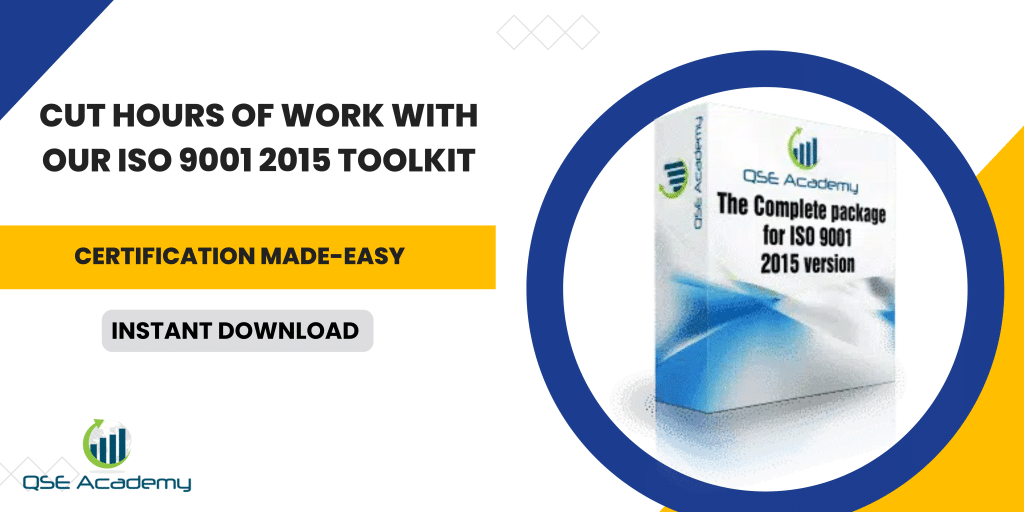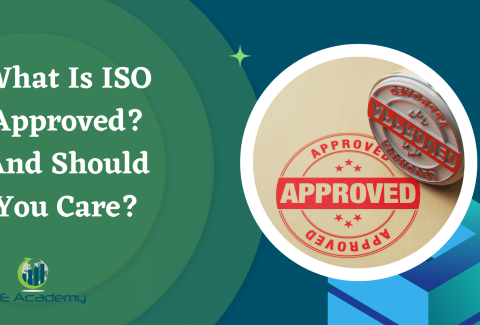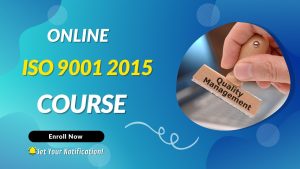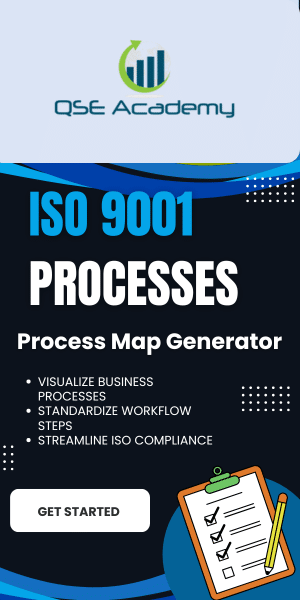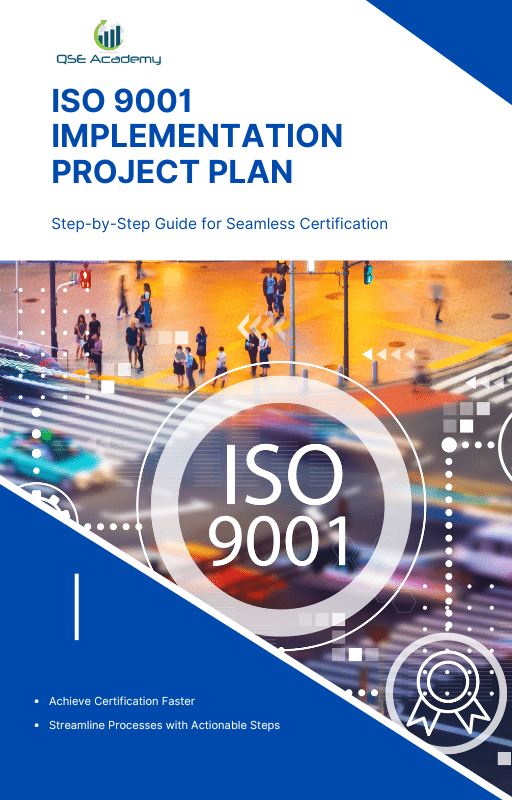How does iso 9001 work?
Last Updated on October 13, 2025 by Hafsa J.
How does iso 9001 work?
Have you ever wondered how businesses consistently deliver top-notch products and services while keeping customers happy? Well, that’s where ISO 9001 comes in. It’s a globally recognized standard for quality management systems, or QMS for short, and it helps businesses stay on track by setting clear guidelines for how things should be done. But you might be asking, “How does ISO 9001 work?”
Let’s break it down. Think of ISO 9001 as a roadmap—a detailed guide that helps organizations organize their processes, improve efficiency, and focus on what really matters: satisfying their customers. Whether you run a small shop or a large corporation, ISO 9001 provides a framework to ensure everything operates smoothly and with purpose.
What’s great about ISO 9001 is that it’s not one-size-fits-all. It’s designed to be flexible and adaptable, meaning it can work for any type of business in any industry. Curious to know how this framework actually operates and benefits businesses? Let’s dive deeper to uncover how ISO 9001 works and why it’s such a game-changer for organizations worldwide.
What is ISO 9001 and Why Does It Matter?
To understand how ISO 9001 works, let’s start with the basics: what is ISO 9001, and why is it such a big deal? Think of it as a rulebook for quality management—a set of guidelines that helps businesses create systems to consistently meet customer expectations and improve their operations. Whether you’re running a small local bakery or managing a multinational corporation, ISO 9001 provides the foundation to ensure your processes are efficient and effective.
So, how does ISO 9001 work in real life? It’s all about structure and accountability. Businesses use ISO 9001 to map out their processes—everything from how they handle customer orders to how they maintain product quality. By following the standard, organizations can pinpoint areas that need improvement, reduce inefficiencies, and deliver better results for their customers.
Why does this matter? Because ISO 9001 isn’t just about ticking boxes or meeting regulatory requirements. It’s about creating a culture of quality where everyone in the organization understands their role and works together to achieve common goals. When a business adopts ISO 9001, they’re making a commitment to their customers and employees to prioritize quality and continuous improvement.
Another reason ISO 9001 matters is its universality. It’s not limited to specific industries or company sizes. Whether you’re in manufacturing, healthcare, education, or even hospitality, ISO 9001 can work for you. It’s designed to be flexible and adaptable, which is part of what makes it so powerful.
By now, you might be starting to see how ISO 9001 works as a practical tool for businesses looking to improve and grow. But there’s so much more to discover about how this standard can be applied and why it’s worth considering. Ready to dive deeper? Let’s keep going!
How Does ISO 9001 Work in Practice?
Now that we’ve covered the basics, let’s talk about how ISO 9001 works in real life. You might think it’s just a set of rules to follow, but it’s so much more than that—it’s a framework that helps businesses create a well-oiled machine. Imagine your business as a puzzle with many pieces: ISO 9001 ensures that all those pieces fit together seamlessly.
So, how does ISO 9001 work? At its core, it’s built around a process-based approach. That means instead of looking at individual tasks or departments, ISO 9001 focuses on how everything flows together. It’s like zooming out and looking at the big picture. By mapping out processes, businesses can see what’s working, what’s not, and where improvements are needed.
One of the key tools in how ISO 9001 works is the Plan-Do-Check-Act (PDCA) cycle. Think of this as a step-by-step method for getting things done. Here’s how it breaks down:
- Plan: Identify your goals, figure out what needs to be done, and set a strategy.
- Do: Put your plan into action.
- Check: Measure the results to see if everything is working as expected.
- Act: Make adjustments and improvements based on what you’ve learned.
This cycle is repeated continuously, helping businesses adapt, improve, and stay ahead of the game.
Another essential part of how ISO 9001 works is its emphasis on customer focus. Everything starts and ends with the customer. Businesses are encouraged to understand what their customers want and then build their processes around meeting (and exceeding) those expectations. Happy customers, after all, are the key to long-term success.
Finally, ISO 9001 also relies on the involvement of everyone in the organization. It’s not just for managers or quality control teams—it’s about creating a culture where everyone plays a role in delivering quality. Whether it’s ensuring consistent product quality, streamlining workflows, or reducing errors, the standard brings the entire team together toward common goals.
By taking this structured, practical approach, ISO 9001 works as a powerful tool to help businesses thrive. But what does it actually look like when you’re implementing it? Let’s explore the steps businesses take to bring ISO 9001 to life.
Key Steps to Implementing ISO 9001
So, you might be wondering, “How does ISO 9001 work when a business actually decides to implement it?” The process might seem a bit overwhelming at first, but don’t worry—it’s simpler than it looks when broken into manageable steps. Let’s walk through how businesses typically approach implementing ISO 9001 and bring the standard to life.
1. Start with a Gap Analysis
The first step in how ISO 9001 works is figuring out where your business currently stands. This is called a gap analysis. Think of it like taking stock of what you’re already doing well and identifying areas where your processes don’t quite match up with ISO 9001 requirements. It’s all about understanding the gaps so you can create a plan to bridge them.
2. Build or Update Your Quality Management System
Next comes the fun part—creating or refining your Quality Management System (QMS). This is where you document your key processes, policies, and procedures. Remember, ISO 9001 isn’t about reinventing the wheel; it’s about ensuring that what you’re already doing is clear, consistent, and effective. A strong QMS is like the backbone of how ISO 9001 works in any organization.
3. Train Your Team and Raise Awareness
ISO 9001 is all about teamwork, so everyone in your organization needs to be on the same page. Training sessions and workshops are a great way to introduce your team to the principles of ISO 9001 and show them how their roles contribute to the bigger picture. When everyone understands how ISO 9001 works, it’s easier to get buy-in and build a culture of quality.
4. Conduct Internal Audits
Once your QMS is up and running, it’s time to test it out. Internal audits are like a dress rehearsal for the real thing. They help you check whether your processes align with ISO 9001 requirements and highlight any areas that might need a little more work. Think of it as a chance to fine-tune everything before moving forward.
5. Pass the Certification Audit
Finally, you’ll bring in a third-party auditor to assess your QMS and ensure it meets the ISO 9001 standard. This is the moment where all your hard work pays off. If everything checks out, you’ll receive your ISO 9001 certification—a badge of honor that shows your commitment to quality and customer satisfaction.
As you can see, the steps involved in how ISO 9001 works are designed to guide businesses through a logical, straightforward process. It’s not about perfection on day one—it’s about creating a solid foundation for continuous improvement. The best part? Every step brings you closer to a stronger, more efficient organization. Ready to keep learning? Let’s dive into how documentation and processes play a critical role in making ISO 9001 work!
The Role of Documentation and Processes in How ISO 9001 Works
Now let’s talk about one of the most important parts of how ISO 9001 works: documentation and processes. While “documentation” might sound a little dry, it’s actually a key ingredient in helping businesses stay organized and consistent. Think of it as your business’s instruction manual—clear, detailed, and easy to follow.
Why Documentation Matters in ISO 9001
Imagine trying to bake a cake without a recipe. You might get lucky, or you might end up with a disaster in the kitchen. That’s kind of what it’s like trying to run a business without proper documentation. ISO 9001 ensures that businesses don’t rely on guesswork. Instead, it emphasizes creating clear guidelines and processes that everyone can follow. This way, you know that the same high standards are being met every time, whether you’re delivering a product or providing a service.
But how does ISO 9001 work when it comes to documentation? It doesn’t mean you need to write down every single thing your business does. Instead, it’s about focusing on what really matters—your core processes, like managing customer orders, handling complaints, or ensuring product quality. The goal is to make these processes so clear that anyone in your team can understand and follow them.
How Documentation Supports Consistency and Improvement
One of the coolest things about ISO 9001 is how it uses documentation to drive improvement. Let’s say your team encounters a problem—like delays in shipping products. With documented processes in place, it’s much easier to pinpoint where things are going wrong. Is it a breakdown in communication? A missing step in the workflow? ISO 9001 helps you identify the issue and make changes to prevent it from happening again. That’s how ISO 9001 works to keep your business running like a well-oiled machine.
Keeping It Simple and Practical
The great thing about ISO 9001 documentation is that it doesn’t have to be overly complicated. In fact, the standard encourages businesses to keep things simple and practical. Whether it’s a straightforward flowchart or a checklist, the idea is to create tools that make life easier for your team. When your processes are clear and easy to follow, everyone knows what to do, and your business runs more smoothly.
Processes: The Backbone of How ISO 9001 Works
Of course, documentation is only part of the puzzle. The real magic happens when your processes are aligned with ISO 9001’s principles. From customer communication to product delivery, every step in your workflow should contribute to the overall goal of quality and customer satisfaction. When your processes are well-designed and well-documented, they become the backbone of how ISO 9001 works to improve your business.
In short, documentation and processes are like the playbook for your business. They ensure that everyone is on the same page, help you fix problems quickly, and create a foundation for continuous improvement. Understanding how ISO 9001 works is all about seeing how these pieces fit together to build a stronger, more efficient organization. Ready to see who benefits from ISO 9001 and how? Let’s explore that next!
Who Benefits from ISO 9001 and How?
When we talk about how ISO 9001 works, it’s impossible not to mention the wide range of benefits it offers. Whether you’re a business owner, an employee, or a customer, there’s something in it for everyone. Let’s break it down and see who benefits the most and how.
For Businesses: Streamlining Operations and Building Trust
Businesses are probably the biggest winners when it comes to ISO 9001. The standard helps organizations streamline their operations by eliminating inefficiencies and creating consistent, repeatable processes. This means fewer mistakes, smoother workflows, and less time spent fixing problems.
But it’s not just about what happens behind the scenes. ISO 9001 certification also builds trust with customers and partners. Think about it—if you had to choose between two companies, wouldn’t you feel more confident choosing the one that follows globally recognized quality standards? That’s how ISO 9001 works to boost a company’s reputation and attract more business.
For Employees: Clear Roles and a Sense of Purpose
Employees also reap the rewards of ISO 9001. When processes are well-documented and clearly defined, everyone knows what’s expected of them. This clarity reduces confusion, minimizes frustration, and helps people focus on doing their jobs well.
Plus, ISO 9001 promotes a culture of teamwork and continuous improvement. Employees are encouraged to share ideas, identify issues, and be part of the solution. When people feel involved and valued, it boosts morale and creates a stronger sense of purpose.
For Customers: Consistency and Satisfaction
Let’s not forget about the customers—they’re at the heart of how ISO 9001 works. The standard is designed with customer satisfaction in mind. By focusing on quality and consistency, businesses can deliver products and services that meet or exceed customer expectations every time.
Imagine ordering a product from your favorite company. You’d expect it to be the same great quality as the last time, right? That’s exactly what ISO 9001 ensures. Customers benefit from reliable service, fewer issues, and a better overall experience.
For Society as a Whole: Raising the Bar for Quality
Finally, ISO 9001 doesn’t just benefit individual businesses and customers—it raises the bar for quality across industries. When more companies adopt the standard, it creates a ripple effect of higher standards, better products, and improved services. This, in turn, builds trust in markets and makes life better for everyone.
When you look at the big picture, it’s easy to see how ISO 9001 works to create a win-win situation for everyone involved. Businesses grow stronger, employees feel more engaged, customers get better products, and industries as a whole improve. But like anything else, it’s not without its challenges. In the next section, we’ll tackle some common misconceptions about ISO 9001 and clear up any confusion. Let’s keep going!
Challenges and Misconceptions About ISO 9001
When people first hear about ISO 9001, they might feel a little intimidated. After all, implementing a global standard for quality sounds like a big undertaking, doesn’t it? But here’s the thing: most of the challenges businesses face come from misconceptions about how ISO 9001 works. Let’s clear up some of the confusion and tackle a few common concerns.
“Isn’t ISO 9001 Too Complicated?”
At first glance, ISO 9001 might seem complex, but it’s actually designed to be straightforward and adaptable. How does ISO 9001 work in this context? By offering a flexible framework that can fit businesses of all sizes and industries. You don’t need to overhaul your entire operation to get started; you simply build on what you’re already doing, step by step.
Think of it like assembling a bookshelf. The instructions might look overwhelming at first, but when you follow them one piece at a time, everything starts to make sense. ISO 9001 works the same way—it’s about breaking things down into manageable steps and focusing on continuous improvement.
“Will It Take Too Much Time and Money?”
Another common misconception is that implementing ISO 9001 is expensive and time-consuming. While it does require some investment, the long-term benefits far outweigh the initial effort. How does ISO 9001 work to offset these costs? By improving efficiency, reducing waste, and preventing errors, it often saves businesses money in the long run.
Plus, the timeline for implementation depends on your organization’s size and complexity. Smaller businesses might achieve certification in a few months, while larger organizations may take longer. Either way, the process is flexible, and you can move at a pace that works for you.
“Is ISO 9001 Just a Paperwork Exercise?”
Many people think ISO 9001 is all about paperwork, but that’s not the case. Yes, documentation is part of how ISO 9001 works, but it’s only one piece of the puzzle. The real focus is on building a culture of quality, improving processes, and creating value for customers. The paperwork exists to support these goals, not to create unnecessary bureaucracy.
“Is ISO 9001 Only for Big Companies?”
This is one of the biggest myths about ISO 9001. In reality, the standard is designed to work for businesses of all sizes, from tiny startups to multinational corporations. How does ISO 9001 work for smaller businesses? By scaling its requirements to fit their needs. You don’t have to have a huge team or endless resources to benefit from ISO 9001—it’s all about using what you have more effectively.
ISO 9001 may have its challenges, but they’re often smaller than they seem once you understand how the standard works. By debunking these misconceptions, it’s clear that ISO 9001 is an approachable, practical tool for businesses of all types. In the next section, we’ll wrap things up with a recap of how ISO 9001 works and why it’s worth exploring for your organization. Stay with me!
Conclusion: How Does ISO 9001 Work and Why It’s Worth It?
By now, you’ve gotten a pretty good idea of how ISO 9001 works and why it’s such a valuable tool for businesses. It’s not just about meeting a set of rules—it’s about creating a system that helps organizations run more efficiently, deliver higher quality, and keep customers happy.
So, how does ISO 9001 work in practice? It starts by giving businesses a clear framework for organizing their processes, ensuring that everyone knows what to do and how to do it. From conducting a gap analysis and documenting workflows to training employees and using the Plan-Do-Check-Act cycle, ISO 9001 is all about breaking things down into simple, manageable steps.
What makes ISO 9001 so effective is its focus on continuous improvement. It’s not a one-and-done certification—it’s a commitment to always finding ways to do things better. Whether it’s reducing errors, improving customer satisfaction, or boosting team collaboration, ISO 9001 works as a powerful guide to help businesses achieve their goals.
And let’s not forget about the flexibility of ISO 9001. No matter your industry or the size of your organization, this standard is designed to adapt to your needs. It’s a practical tool that can help a small family business thrive just as much as it helps a large corporation.
If you’ve been on the fence about exploring ISO 9001, consider this your sign to take the leap. Understanding how ISO 9001 works is the first step toward creating a stronger, more efficient, and customer-focused organization. The rewards far outweigh the effort, and with the right approach, implementing ISO 9001 can be an exciting and transformative journey for your business.
Ready to see how ISO 9001 works for your organization? Start small, stay consistent, and let this incredible framework guide you toward lasting success. The results might just surprise you!
Ready to move from ISO 9001 theory to implementation?
Get the exact tools you need to write your documentation, train your team, map your processes, and pass your audit—without wasted time or guesswork.

make ISO standards less intimidating and more approachable for everyone.
Whether it’s ISO 9001, ISO 22000, or the cosmetics-focused ISO 22716, I’ve spent my career
turning complex jargon into clear, actionable steps that businesses can actually use.
I’m not here to call myself an expert—I prefer “enthusiast” because I truly love what I do.
There’s something incredibly rewarding about helping people navigate food safety and quality management systems
in a way that feels simple, practical, and even enjoyable.
When I’m not writing about standards, you’ll probably find me playing Piano 🎹, connecting with people, or diving into my next big project💫.
I’m an engineer specialized in the food and agricultural industry
I have a Master’s in QHSE management and over 12 years of experience as a Quality Manager
I’ve helped more than 15 companies implement ISO 9001, ISO 22000, ISO 22716, GMP, and other standards
My clients include food producers, cosmetics manufacturers, laboratories, and service companies
I believe quality systems should be simple, useful, and efficient.


